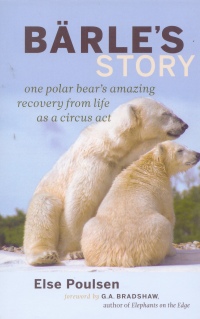| ________________
CM . . .
. Volume XXI Number 19 . . . . January 23, 2015
excerpt:
Barle’s Story is the incredible tale of a female polar bear who might have been born in the Canadian Arctic, but who spent 13 years with a circus in Puerto Rico in dreadful conditions. After years of abuse, not the least being the tropical heat, she was rescued and shipped to the Detroit Zoo in 2002 where she made a complete recovery and lived out the rest of her life in an environment as close to what she would have experienced in nature as was possible in the confines of a zoo. Barle had a tumour and was euthanized when she was 28-years-old. Author Else Poulsen, who helped Barle make the successful transition from the circus to the zoo, wrote that “Barle was the most abused bear I had ever been assigned to work with in both the longevity and the circumstances of her abuse.” Barle’s Story is both a sad and a joyous one. It is sad because her early life was so dreadful but joyous, too, because she adapted so well to the enriched environment of the zoo and became a happy and contented bear. Her story will be appealing to all readers from young teens to adults. It is suitable for classroom use or as a book club selection. It raises a number of controversial issues, is very informative, well-written and hard to stop reading. Readers may be surprised to learn what bears in zoos are fed. In addition to various types of fish, they may also be fed applesauce, butterscotch pudding, cheerios and raisins. An ill bear in the Detroit zoo was offered, among other things, ham hocks, roast chicken, and a turkey leg. Barle’s Story has an Index, Notes, References and 16 pages of black and white functional photographs in the middle of the book. It has 10 chapters of varying lengths. One of the most serious issues raised by Poulsen is that of man’s relationship to animals in the wild. How should they be treated as society encroaches on their traditional habitats? Why, for example, do bears that happen to live near a city become nuisance bears when they eat our garbage and have to be shot? Such animal abuse was taken to the extreme in Alberta in 2011 when 145 black bears were killed in the tar sands. Another issue that Poulsen doesn’t raise, but which is at the heart of man’s relationship with animals, is that of zoos. Should there be zoos at all? Should wild animals be incarcerated simply to provide entertainment for people? Poulsen shows that life in a good zoo is much better than life in a circus, but how much better would it be to leave animals in their natural environment? There are a number of unusual (to this reviewer) terms used in Barle’s Story. These are not a hindrance but a bonus because they allow the reader to expand his/her vocabulary, one of the benefits of reading a good book. Else Poulsen has over twenty five years’ experience working with bears in the wild and in captivity. She has a diploma in zoo keeping and a BSc in biology and previously wrote Smiling Bears, a story about the emotional life of bears. She is very knowledgeable about bears and has a deep affinity for them. Highly Recommended. Thomas F. Chambers, an author and retired college teacher, lives in North Bay, ON.
To comment on this title or this review, send mail to cm@umanitoba.ca.
Copyright © the Manitoba Library Association. Reproduction for personal use is permitted only if this copyright notice is maintained. Any
other reproduction is prohibited without permission.
CM Home | Next Review | Table of Contents for This Issue - January 23, 2015 | Back Issues | Search | CM Archive | Profiles Archive |
